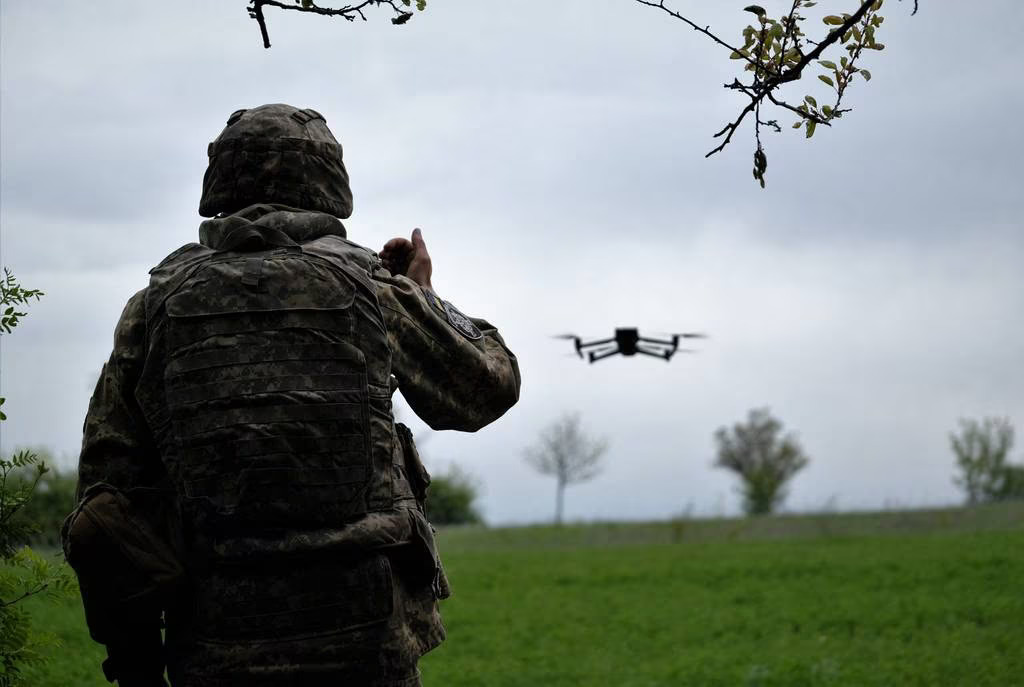Give the Defense Innovation Unit a Slice of Ukraine Funds
WAR RACKET--CATASTROPHE CAPITALISM, 22 May 2023
Maj. Gen. John Ferrari (ret.) and Charles Rahr | Defense News – TRANSCEND Media Service
DISCLAIMER: Publication of articles in the ‘War Racket’ section of TMS does not mean that we subscribe, agree or support their content—quite the opposite. Our aim is to inform and present the facts from diverse angles and perspectives so that our readers may form educated, intelligent opinions AGAINST WARS.
**********************************

A Ukrainian serviceman flies a drone near the town of Bakhmut on May 8, 2023, amid the Russian invasion of Ukraine. (Sergey Shestak/AFP via Getty Images)
16 May 2023 – Calls to make Ukraine a laboratory and a testing ground for our own [USA] weapons and platforms are the right ones. Its conflict with Russia presents a tremendous opportunity for the Pentagon, industry and our allies to learn how the West’s weapons fare under real-world, high-intensity combat conditions. But Ukraine shouldn’t just be a laboratory for our own equipment; it should also be an accelerator, speeding up the adoption of commercial technologies that have military applications.
To become that accelerator, Congress could give the Pentagon’s Defense Innovation Unit a slice of security assistance funds bound for Ukraine in coming aid packages.
In announcing the creation of DIU in 2015, late-Defense Secretary Ash Carter noted that the organization would “strengthen existing relationships and build new ones; help scout for new technologies; and help function as a local interface for the department. Down the road, they could help startups find new work to do with [the Department of Defense].”
Eight years has since passed since its founding, and it’s safe to say that DIU has met each of these aims, but maybe not at the scale needed to change the Pentagon. Consistent with the organization’s most basic objective in bringing commercial technologies into the hands of our warfighters, DIU has transitioned 52 technologies and platforms into Department of Defense contracts since 2016. Those 52 projects, spanning capabilities in unmanned aircraft systems, predictive maintenance and a variety of other areas, come from 48 different companies and have a combined contract ceiling of $4.9 billion.
While $4.9 billion may be a drop in the bucket for a department that annually receives hundreds of billions of dollars in appropriations, partially accounting for that relatively low cost to the department is private capital. According to DIU, its 52 successfully transitioned projects are supported by more than $18 billion in private investment.
As an additional sign of the organization’s success, the rate at which DIU is transitioning technologies is increasing. The transition contracts awarded for commercial tech more than doubled between fiscal 2021 and fiscal 2022, increasing from 8 to 17.
In successfully helping commercial technologies enter the hands of our warfighters, DIU has brought a much-needed shakeup to an acquisition system that’s overly bureaucratic and, by and large, favors large prime contractors over innovative startups. Despite its success, the administration is considering cutting the organization’s budget in the coming fiscal year.
As described by our colleague at the American Enterprise Institute, Elaine McCusker, the administration appears to be slashing DIU’s budget by 6.3% in FY24, and even as much as 26% if funding for capital budgets and for its sister organization, the National Security Innovation Network, are taken into account. Congress should resist such a damaging cut and consider adding more funds to DIU in the near term through the Ukraine Security Assistance Initiative.
One of the major impediments to the DoD’s adoption of commercial technologies — and why it continues to fall behind — is its fear of and rigid restrictions on allowing systems and software to operate on the DoD network. Only the large defense primes and well-funded startups can withstand the timeline and cost of getting the authority to operate. The Ukrainians have no such restriction, and as such can and are becoming the perfect laboratory for cutting-edge technologies and software.
Giving DIU even a small percentage of the money dedicated to Ukraine could make a real difference. If Congress were to provide DIU 4% of the funds obligated to Ukraine during the last fiscal year, DIU would receive around $252 million — well over the $203 million DIU awarded in prototype contracts that year. Doing so would accelerate existing prototyping efforts, bringing needed technologies to scale on a faster timeline.
In addition, such funds would allow DIU to facilitate contracts for some of its already transitioned technologies. That would put money toward startups that routinely cannot make it through the DoD valley of death. In particular, DIU could focus its investments in software, artificial intelligence and networked devices, all of which have extreme difficulty getting traction in the DoD ecosystem.
While the specifics of this proposal would certainly have to be worked out between Congress and the Pentagon, there is no doubt that it’s needed for the Ukrainians but also for the tech startups in the United States. The Ukrainians have enthusiastically adopted commercial technologies on the battlefield, from the Starlink satellite constellation to the use of cheap drones, and used them to great effect. However, many tech startups cannot afford to bankroll their products onto the battlefield, but DIU could. Adding more to the mix would be a welcome addition for a force that is constantly tinkering and MacGyver-ing its weapons and tech.
__________________________________________
Maj. Gen. John Ferrari is a senior nonresident fellow at the American Enterprise Institute think tank. He previously served as a director of program analysis and evaluation for the Army.
Charles Rahr is a research assistant at AEI.
Submitted by TRANSCEND Member Alberto Portugheis
Go to Original – defensenews.com
Tags: Anglo America, Arms Industry, Arms Race, Arms Trade, Bullying, Capitalism, Corruption, Elites, Finance, Full Spectrum Dominance, Greed, Hegemony, Imperialism, Mafia, Military Industrial Media Complex, NATO, Organized crime, Pentagon, Profits, Proxy War, Russia, Technology, USA, Ukraine, Warfare, World Order
DISCLAIMER: The statements, views and opinions expressed in pieces republished here are solely those of the authors and do not necessarily represent those of TMS. In accordance with title 17 U.S.C. section 107, this material is distributed without profit to those who have expressed a prior interest in receiving the included information for research and educational purposes. TMS has no affiliation whatsoever with the originator of this article nor is TMS endorsed or sponsored by the originator. “GO TO ORIGINAL” links are provided as a convenience to our readers and allow for verification of authenticity. However, as originating pages are often updated by their originating host sites, the versions posted may not match the versions our readers view when clicking the “GO TO ORIGINAL” links. This site contains copyrighted material the use of which has not always been specifically authorized by the copyright owner. We are making such material available in our efforts to advance understanding of environmental, political, human rights, economic, democracy, scientific, and social justice issues, etc. We believe this constitutes a ‘fair use’ of any such copyrighted material as provided for in section 107 of the US Copyright Law. In accordance with Title 17 U.S.C. Section 107, the material on this site is distributed without profit to those who have expressed a prior interest in receiving the included information for research and educational purposes. For more information go to: http://www.law.cornell.edu/uscode/17/107.shtml. If you wish to use copyrighted material from this site for purposes of your own that go beyond ‘fair use’, you must obtain permission from the copyright owner.
Read more
Click here to go to the current weekly digest or pick another article:
WAR RACKET--CATASTROPHE CAPITALISM:
